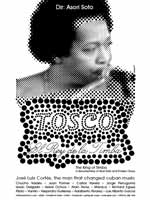 “Nuestro objetivo final es nada menos que lograr la integración del cine latinoamericano.
Así de simple, y así de desmesurado”.
“Nuestro objetivo final es nada menos que lograr la integración del cine latinoamericano.
Así de simple, y así de desmesurado”.
Gabriel García Márquez
Presidente (1927-2014)


-

Más que estatua de salPor Dean Luis ReyesUna de las reglas de oro que cumple de maravillas El Tosco: el Rey de la Timba (2007), primer largometraje de Asori Soto, es la de no aburrir. Ello, trabajando sobre una de las figuras más polémicas y pintorescas de la música popular cubana de los últimos 20 años: José Luis Cortés, más conocido por El Tosco.
Y digo lo anterior porque, mirado desde la perspectiva del habitual documental de personalidad cultural hecho en Cuba, donde se propende a hacer la alabanza del elegido, a reiterar lauros y a dar visiones angelicales de su trayectoria vital, esta película corría el riesgo de caer en el facilismo apologético. O del aburrimiento, que en el caso de El Tosco sería doble pecado –pues se trata de uno de los personajes menos canónicos del panorama cultural reciente.
Nacido y criado en un barrio marginal de provincia, formado en la Escuela Nacional de Arte y miembro consecutivo de Van Van, Irakere y NG La Banda (agrupación esta última que creó y sostiene hoy), ninguno de los linimentos culturales o elitistas que soportó (incluso una formación envidiable de flauta clásica) lo despojaron de esa consistencia marginal, de la violencia propia de los grupos subculturales, que se ha convertido en un atributo de su música.
Asori tenía un reto difícil al moverse por un terreno donde, además de la difícil figura que biografiaba, debía apoyarse en su consentimiento y apoyo para el rodaje, que financiaba con medios propios y a título personal. Por otro lado, no otra cosa que justamente biografiar perseguía el realizador: reconstruir la trayectoria personal y profesional de un hombre que ha provocado a lo largo de los años toda clase de discusiones dentro del campo cultural cubano. O sea, eso que la televisión de vocación sensacionalista o los especiales de MTV hacen a la perfección, pero que en Cuba todavía ni se sueña.
De ahí que Asori salga airoso al reunir, entre testimonios exclusivos y material de archivo, imágenes testimoniales y direct cinema, video clips y conciertos en vivo, una cantidad generosa de contenidos con que construir su relato cronológico, límpido, ajeno a subtextos autorales ni a juegos formales con el material.
El resultado es un documental ligero pero eficaz. El uso de las entrevistas recae en reiteraciones innecesarias, y por momentos los epítetos elogiosos hubieran necesitado mejores argumentos que los sostuviesen. Igualmente, algunas comparecencias están de más, no importa el peso de la celebridad a la que tuvo acceso el director. Una falta de criterio decisivo afecta también la estructura, que por momentos queda al pairo y pierde su tensión general. Y ciertos apuntes polémicos quedan como esbozados, porque seguir horadando es material para otra película.
Pero hay un segmento que dice todo del tratamiento que pretende hacer Asori de su personaje: el “viaje a la semilla” que, como golpe de efecto, ubica casi al final de su película. Aquí Cortés y el equipo de rodaje viajan al Condado, mítico barrio de mala reputación de la ciudad de Santa Clara, donde naciera y creciera el músico. El trayecto se cumple en una guagua refrigerada de uso turístico, alquilada para la ocasión, y en el camino los viajeros meriendan en paraderos para turistas. El barrio es otro mundo, de calles mal definidas y casitas maltrechas, niños sin camisa y gente pobre. La casa adonde entra el Tosco parece a punto de venirse abajo. Pero no hay manipulación, ni musiquitas melosas, sino el registrar la natural interacción del hijo pródigo con la gente que arma un sorteo de tragos de ron malo y remembranzas tranquilas. Sin demasiado criterio de parte del director, la cámara es un revoloteo de rostro en rostro y al final se canta una canción a un orisha. El recién venido no resalta, ni se subraya su don mesiánico. Hay un fundirse humilde.
El Rey de la Timba acaba siendo una mirada no por carente de exigencia menos valiosa. Audacias no le faltan, y virtud crítica tiene la necesaria. Cuando se trata de juzgar al creador o a la celebridad cultural, paladear su obra y verlo hacer y ser bastan para calar la importancia real de su trabajo. Aquí, además, está la búsqueda de la humanidad de un animal complejo.
Como que la televisión ha sustituido el rol que en otro tiempo jugaban como garantes de la memoria visual la fotografía y el cine, este viaje al mundo de un músico que es más que estatua de sal o entertainer de las noches de sábado, tiene valor inestimable. Y es que hace unas horas, mientras revisaba un viejo documental del cine cubano acerca de María Teresa Vera, una de las imprescindibles de la cancionística popular cubana de casi todo el siglo XX, me preguntaba por qué tenía que conformarme con escuchar a sus colegas, compañeros carnales y músicos herederos de su canto, y tan solo verla en fotos de estudio o en unas imágenes sepia, sin sonido, en las que canta sin voz.
 More than a salt statue
More than a salt statue
By Dean Luis Reyes
One of the golden rules that Asori Soto follows wonderfully in his first feature film El Tosco: el Rey de la Timba (2007) is that of not being dull. This, working with one of the most controversial and picturesque stars of the Cuban popular music of the last 20 years: José Luis Cortés, better known as El Tosco.
And I say this because, taking into account the habitual perspective of documentaries devoted to cultural personalities made in Cuba, where the tendency is to praise the chosen person, reaffirm eulogies, and give angelical visions of their vital antecedents, this film ran the risk of being a simplistic apology, or being dull, which in the case of El Tosco would be a double sin-since he is one of the least canonical characters of the recent cultural scenario.
Born and bred in a provincial marginal neighborhood, trained at the National School of Art and member of Van Van, Irakere and NG La Banda, consecutively, (the latter is the band that he created and still directs), none of the elitist or cultural guidelines that he sustained (including an enviable training in classical flute) divested him from his marginal consistency, the violence pertaining to sub cultural groups, which has become an attribute in his music.
Asori had a difficult challenge, on one hand; he had to move along in a ground where, besides working with the biography of a difficult personality, he needed his consent and support for the shooting, which he financed with his own financial means. On the other hand, the filmmaker’s intention was just to work with the biography: put together the pieces of the personal and professional antecedents of a man who has provoked through the years all sorts of disputes in the Cuban cultural field. That is, he wanted to make what the sensationalist television or MTV can do to perfection but in Cuba is not even a dream yet.
Thereof, Asori succeeded when he put together unique testimonies and archive materials, testimonial images and direct cinema, video clips and live concerts, a generous amount of content that supported the chronological narrative, with transparency, extraneous to author’s opinions or formal manipulation of the material.
The result is a light but effective documentary. The use of interviews falls back on unnecessary reiterations, and some of the complementary epithets would have needed more arguments to support them. Likewise, some appearances are unnecessary, no matter how famous the celebrity the director could access to. A lack of critical criterion also affects the structure which is sometimes left at random and loses general tension. Also, some polemic notes are just outlined because further exploration would be the material for a new film.
But there is a segment that speaks in itself of the treatment that Asori intends to apply to her character: the “trip to the root” that, as a final effect, she places almost at the end of her film. Here, Cortés and the shooting team travel to Condado, a mythical ill-famed neighborhood in the City of Santa Clara, where the musician was born and grew up. The route is carried out in an air conditioned bus for tourists use, rented for the occasion, during the trip, the travelers have snack in regular stops for tourists. The neighborhood is another world, ill-defined streets, ruined little houses, children who do not wear shirts and poor people. The house el Tosco enters is about to collapse. But there is no manipulation, or obsequious music, only the recording of the natural interaction of the prodigal son with the people who share rounds of cheap rum and quiet remembrances. Without too much criteria on the part of the director, the camera travels from face to face, and at the end a song is dedicated to an orisha. The new arrival does not stand out; his messianic gift is not emphasized. There is a humble merging together.
El Rey de la Timba ends up being a no less valuable glance, even in its deficit of exigency. It does not lack astuteness, and it has the necessary critical virtue. When the time comes to judge the artist or the cultural celebrity, tasting his work and watching him doing and being are enough to penetrate the real importance of his work. There is also here the search for the humanity of a complex animal.
Since the television has assumed the role, in other times played by photography and movies, of warrantors of the visual memory, this trip to the world of a musician who is more than salt statue or Saturday night entertainer, has a priceless value. And it is just that a few hours ago, while I was reviewing an old Cuban documentary about María Teresa Vera, one of indispensable artists of Cuban popular songs of the XX century, I was wondering why I had to resign myself to listening to her colleagues, blood fellows and musicians who inherited her songs, and just see her in pictures or in sepia-tinted images, without sound, singing without a voice.
















